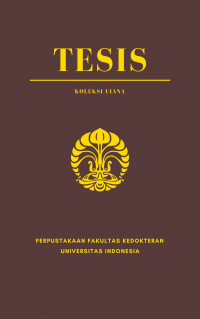Tesis
Faktor yang Memengaruhi Kebocoran Reseksi Anastomosis Kolon di RSCM = Factors Affecting Colon Anastomotic Resection Leakage in RSCM.
Latar Belakang: Kebocoran anastomosis merupakan komplikasi pada pembedahan kolorektal. Banyak faktor yang memngaruhi kejadian kebocoran anastomosis namun studi terbaru peran mikrobiota menjadi salah satu pencetus kebocoran anastomosis. Kasus kebocoran anastomosis berkisar 3-18 % yang meningkat seiring berbagai faktor yang dimiliki oleh pasien. Disbiosis mikrobiota selanjutnya dapat memicu gangguan penyembuhan dan merusak kolagen pada lumen usus. Diperlukan penelitian prospektif untuk dapat menilai karakteristik kebocoran anastomosis. Metode: Dilakukan pengambilan sampel pascaanastomosis lalu dilakukan kultur jaringan. Lendir mukosa dipisahkan dari lumen untuk mendapatkan gambaran mikrobiota pada lumen. Kejadian kebocoran diikuti 5 hari pascaanastomosis dan dinilai faktor-faktor yang memengaruhi kejadian kebocoran anastomosis. Data ditampilkan dalam bentuk deskriptif tabel dan persentase. Hasil: Terdapat satu kasus kebocoran anastomosis pada operasi lower anterior resection, usia 65 tahun, ASA III dengan komorbid hipertensi tingkat II. Didapat bakteri Escherichia coli terbanyak ditemukan selain Proteus spp dan Klebsiella spp. Bakteri ini merupakan bakteri komensal saluran cerna dan belum diketahui patogenitasnya serta hubungan dengan pemberian antibiotik preoperasi. Kesimpulan: Belum diketahuinya strain patogen pada temuan hasil kultur. Karakteristik subjek memiliki jarak anastomosis ke anal < 10 cm, ASA III, usia > 65 tahun dan memiliki komorbid tidak signifikan memiliki hubungan kejadian kebocoran anastomosis.
Kata Kunci: Disbiosis, Mikrobiota, Kebocoran Anastomosis
Background: Anastomotic leak is a complication of colorectal surgery. Many factors influence the incidence of anastomotic leakage, but recent studies on the role of the microbiota are one of the triggers for anastomotic leakage. Anastomotic leak cases range from 3-18% which increases with various factors possessed by the patient. Microbiota dysbiosis can then trigger healing disorders and damage collagen in the intestinal lumen. Prospective studies are needed to assess the characteristics of anastomotic leak. Methods: Post-anastomosis samples were taken and then tissue culture was performed. Mucous mucus is separated from the lumen to obtain an image of the microbiota in the lumen. The incidence of leakage was followed 5 days post-anastomosis and assessed the factors that influence the incidence of anastomotic leak. The data is displayed in the form of descriptive tables and percentages. Results: There was one case of anastomotic leak during lower anterior resection surgery, age 65 years, ASA III with comorbid grade II hypertension. The most Escherichia coli bacteria were found besides Proteus spp and Klebsiella spp. These bacteria are commensal bacteria of the gastrointestinal tract and the pathogenicity and relationship with preoperative antibiotics are not known. Conclusion: There is no known pathogenic strain in the culture findings. Characteristics of the subject had an anastomotic distance to the anal < 10 cm, ASA III, age > 65 years and had no significant comorbid association with the incidence of anastomotic leak.
Keywords: Dysbiosis, Microbiota, Anastomotic Leaks
- Judul Seri
-
-
- Tahun Terbit
-
2020
- Pengarang
-
Frengky Bermana - Nama Orang
Wifanto Saditya Jeo - Nama Orang - No. Panggil
-
T20472fk
- Penerbit
- Jakarta : Program Studi Ilmu Bedah., 2020
- Deskripsi Fisik
-
xiv, 41 hal; ill; 21 x 30 cm
- Bahasa
-
Indonesia
- ISBN/ISSN
-
-
- Klasifikasi
-
NONE
- Edisi
-
-
- Subjek
- Info Detail Spesifik
-
Tanpa Hardcopy
| T20472fk | T20472fk | Perpustakaan FKUI | Tersedia |


Masuk ke area anggota untuk memberikan review tentang koleksi